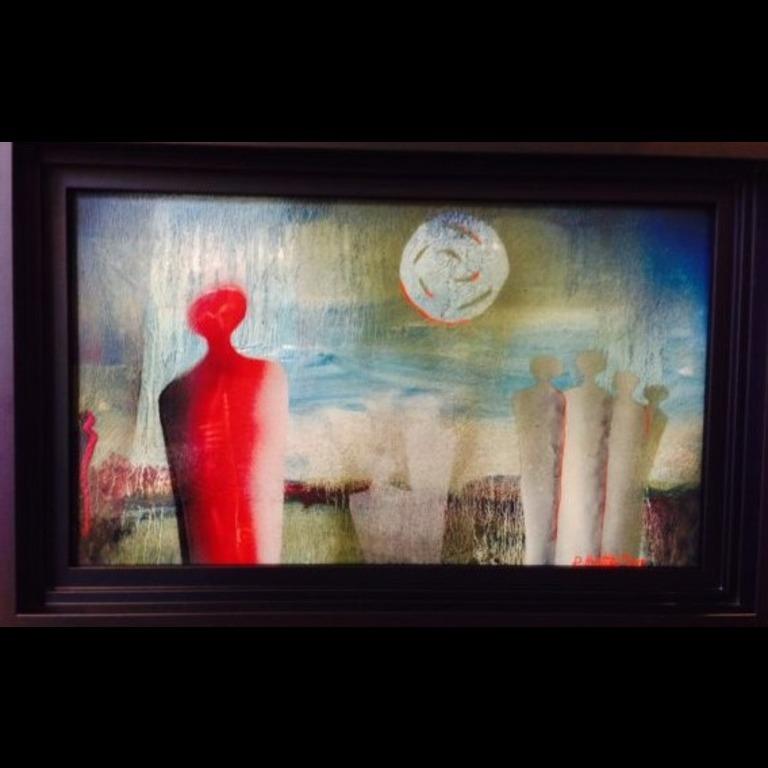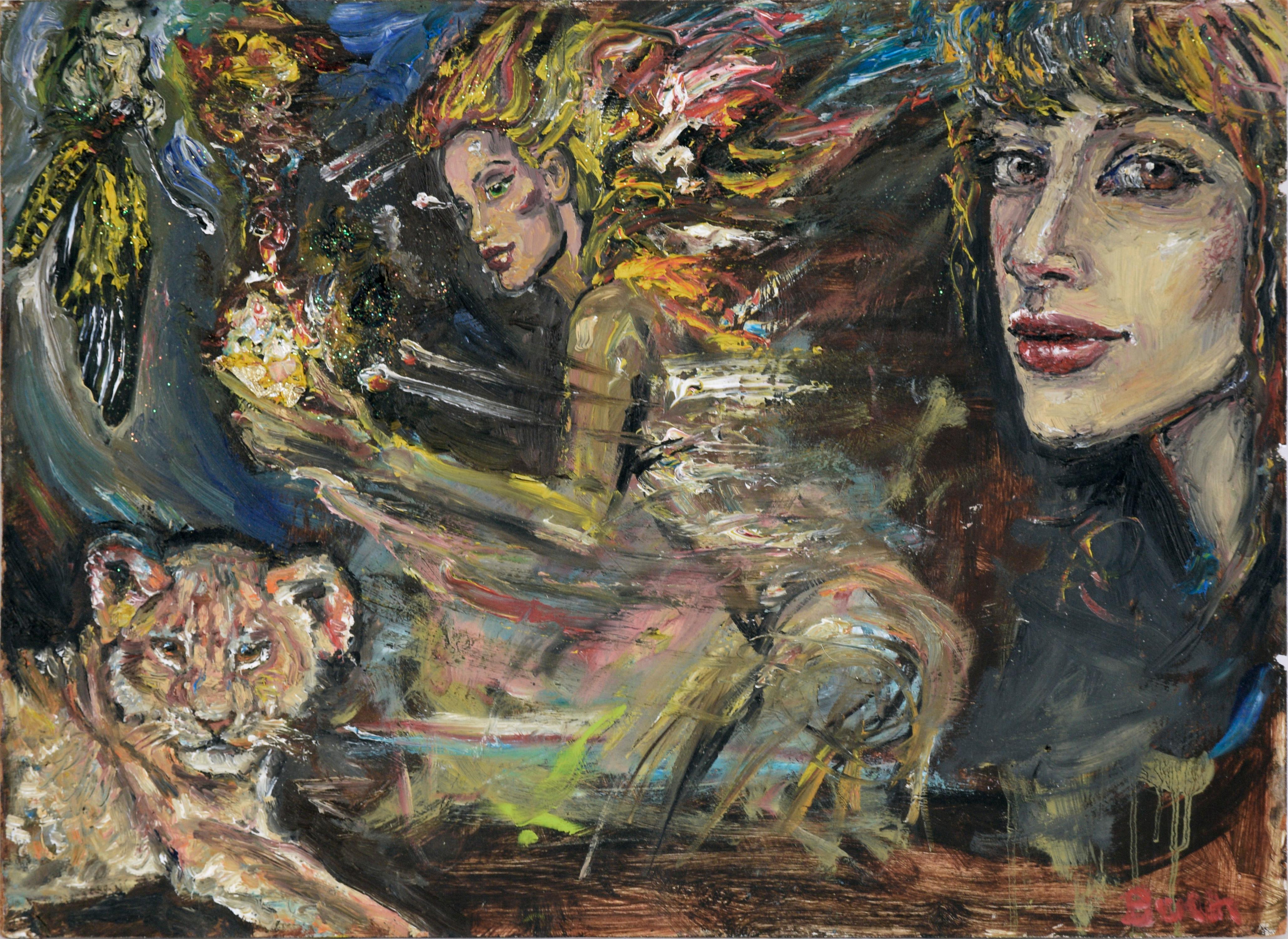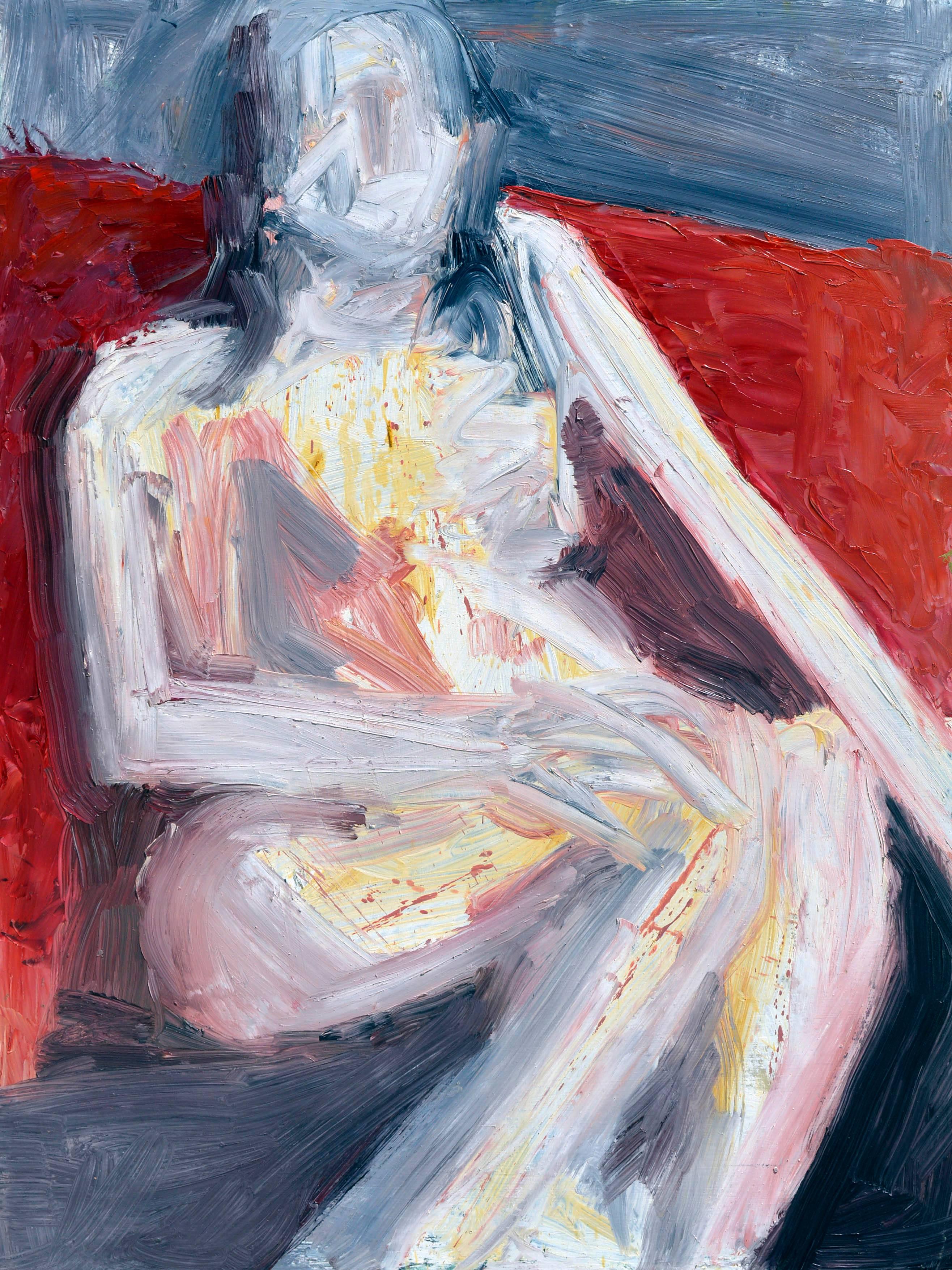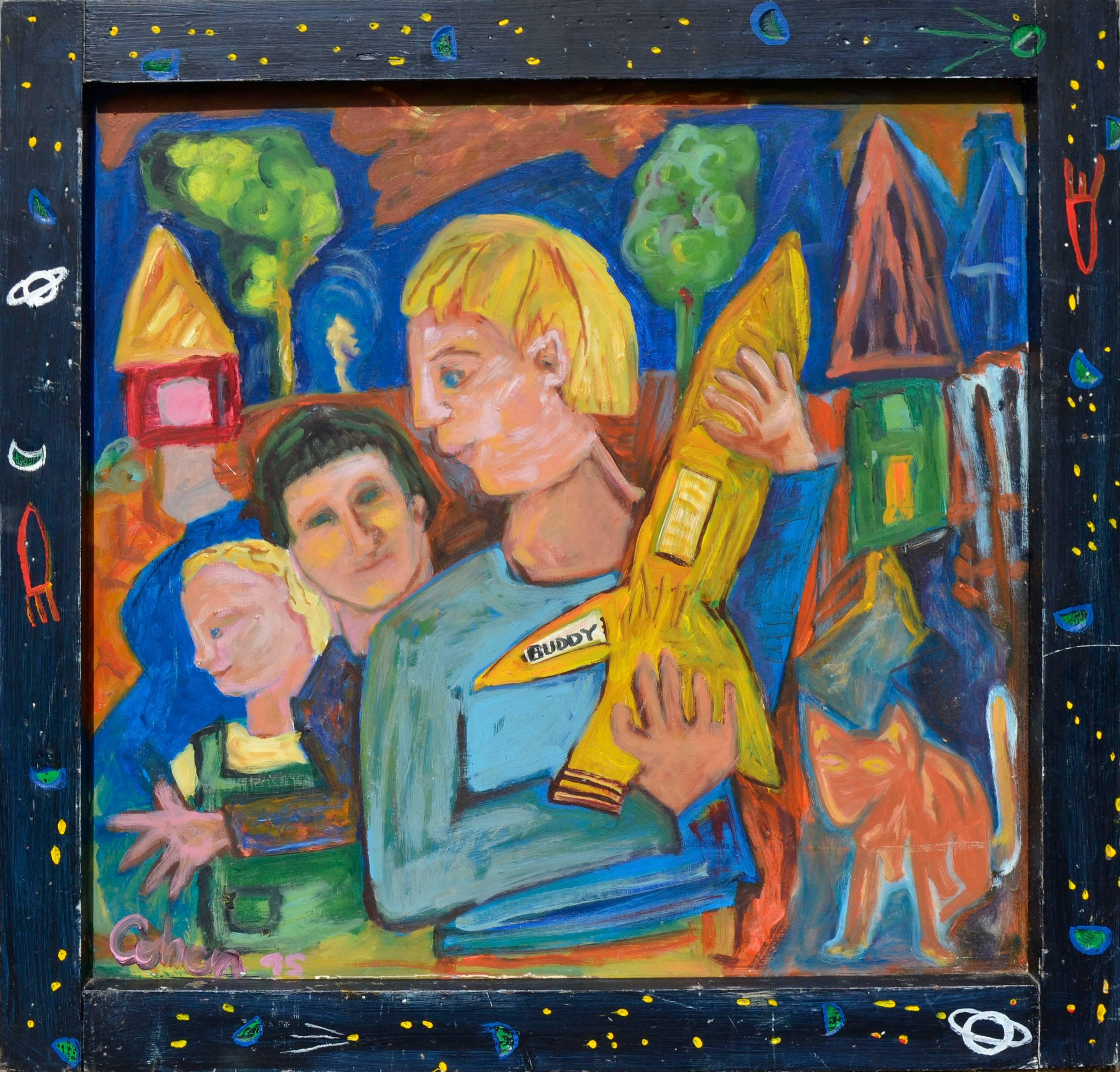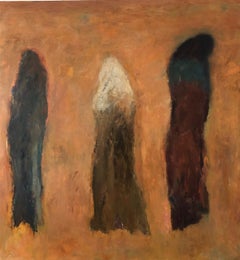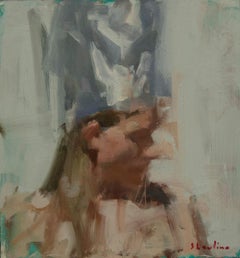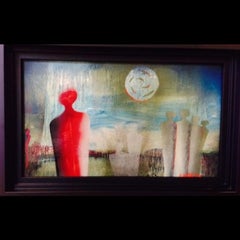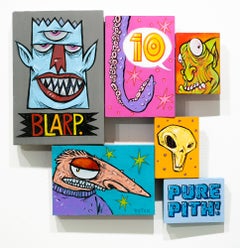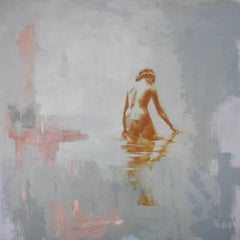
Full Moon
View Similar Items
Diana TremaineFull Moon 2017
2017
About the Item
- Creator:Diana Tremaine (American)
- Creation Year:2017
- Dimensions:Height: 24 in (60.96 cm)Width: 24 in (60.96 cm)Depth: 1.5 in (3.81 cm)
- Medium:
- Movement & Style:
- Period:
- Condition:
- Gallery Location:Burlingame, CA
- Reference Number:Seller: TRED1stDibs: LU37532373671
Diana Tremaine
Diana Tremaine is a bicoastal New York City-born artist who studied and taught in both Northern and Southern California. She later moved to Montana in search of spiritual space and room to breathe, where she now works and lives with her family. She uses swans as a metaphor for beauty and resilience rising above chaos during difficult times. Tremaine's dynamic, representational and nature-centric oil paintings reflect a search for truth and meaning. Tremaine develops brushstrokes and marks by adding and then obliterating some of the stories in a free-association editorial process of discovering what is most important and lasting. The melancholy images echo her experiences in an autobiographical fashion, but they are also universal and touch upon and evoke our collective memories like ghosts of what was. Created with a limited palette, there is visual poetry in her surfaces, including the tension that exists when simultaneously holding on and letting go. Tremaine has exhibited widely and with success.
- GazaBy Roy BorroneLocated in Burlingame, CAGaza, a Provocative and haunting figurative work painted with warm golden and burgundy red hues. ‘Gaza’ takes its inspiration from images of women in turmoil that the artist has seen...Category
21st Century and Contemporary Contemporary Abstract Paintings
MaterialsCanvas, Linen, Wax, Oil, Alkyd, Wood Panel
$15,000 - Torso No. 9, 2013 / figurative abstract expressionismBy John GoodmanLocated in Burlingame, CA'Torso No. 9, 2013' is professionally framed in a contemporary museum quality clear maple hardwood frame. The artwork itself is 23 1/2 x 20 inches. The outer frame dimensions are 31 ...Category
21st Century and Contemporary Contemporary Figurative Paintings
MaterialsOil, Panel
- CrownBy David ShevlinoLocated in Burlingame, CADavid Shevlino female figures beautifully link traditional representation with abstraction. Through Shevlino’s sensuous application of paint, his use of broad brushstrokes followed b...Category
21st Century and Contemporary Contemporary Figurative Paintings
MaterialsOil, Panel
- Gold MaskBy David ShevlinoLocated in Burlingame, CADavid Shevlino female figures beautifully link traditional representation with abstraction. Through Shevlino’s sensuous application of paint, his use of broad brushstrokes followed by a tightening up of the composition, and his making of spontaneous, gestural marks, the artist creates living, breathing figures that not only stand before us, but move, beckon, and dance. Gold Mask...Category
21st Century and Contemporary Contemporary Figurative Paintings
MaterialsOil, Panel
- Ghost of a Chance / oil on canvas musically inspired lush colorBy Stephen HenriquesLocated in Burlingame, CA'Ghost of a Chance' a clear and vibrant oil on canvas painting in green, pink, blue, sand. Henriques' canvases offer a place to rest your eyes and mind and are a place where color re...Category
21st Century and Contemporary Contemporary Abstract Paintings
MaterialsCotton Canvas, Oil
- Backflipping Stop / assemblage paintingBy Kim FrohsinLocated in Burlingame, CADiver diving, doing a backflip, in the blue and black, grey and green vertical work of original art, 'Backflipping Stop' from multidisciplinary visual artist Kim Frohsin, who created...Category
21st Century and Contemporary Contemporary Abstract Paintings
MaterialsAcrylic Polymer, Ink, Mixed Media, Acrylic, Photographic Paper
- David Hostetler Oil Painting Colorful Group Figurative People Anasazi IndianBy David HostetlerLocated in Nantucket, MADavid was inspired by the Anasazi petroglyphs with these shapes of the figures in this painting. It is an oil painting on Masonite. The frame is black wood- a shadow box concept. The...Category
2010s Contemporary Figurative Paintings
MaterialsMasonite, Oil
- "Pure Pith", Colorful Acrylic Painting, Text, Comic, IllustrationLocated in Philadelphia, PAThis wall-hanging artwork titled "Pure Pith" is an original artwork by Christian "Patch" Patchell made of acrylic paint on wood and masonite. This piece measures approximately 12"h x...Category
21st Century and Contemporary Contemporary Figurative Paintings
MaterialsWood, Masonite, Acrylic
- Women and a Tiger Cub - Pop Art in Oil and Mixed Media on MasoniteLocated in Soquel, CAWomen and a Tiger Cub - Pop Art in Oil and Mixed Media on Canvas Pop art by George "Milo" Buck (American, b. 1952). In the center of the composition a woman is running to the left. ...Category
21st Century and Contemporary Pop Art Figurative Paintings
MaterialsGlitter, Oil, Masonite
- Inevitable Day – Birth of the Atom oil and tempera painting by Julio De DiegoBy Julio de DiegoLocated in Hudson, NYJulio De Diego’s Atomic Series paintings made an extraordinary statement regarding the shock and fear that accompanied the dawn of the nuclear age. In the artist’s own words, “Scientists were working secretly to develop formidable powers taken from the mysterious depths of the earth - with the power to make the earth useless! Then, the EXPLOSION! . . . we entered the Atomic Age, and from there the neo-Atomic war begins. Explosions fell everywhere and man kept on fighting, discovering he could fight without flesh.” To execute these works, De Diego developed a technique of using tempera underpainting before applying layer upon layer of pigmented oil glazes. The result is paintings with surfaces which were described as “bonelike” in quality. The forms seem to float freely, creating a three-dimensional visual effect. In the 1954 book The Modern Renaissance in American Art, author Ralph Pearson summarizes the series as “a fantastic interpretation of a weighty theme. Perhaps it is well to let fantasy and irony appear to lighten the devastating impact. By inverse action, they may in fact increase its weight.” Bibliography Art in America, April 1951, p.78 About this artists: Julio De Diego crafted a formidable persona within the artistic developments and political struggles of his time. The artist characterized his own work as “lyrical,” explaining, “through the years, the surrealists, the social-conscious painters and the others tried to adopt me, but I went my own way, good, bad or indifferent.” [1] His independence manifested early in life when de Diego left his parent’s home in Madrid, Spain, in adolescence following his father’s attempts to curtail his artistic aspirations. At the age of fifteen he held his first exhibition, set up within a gambling casino. He managed to acquire an apprenticeship in a studio producing scenery for Madrid’s operas, but moved from behind the curtains to the stage, trying his hand at acting and performing as an extra in the Ballet Russes’ Petrouchka with Nijinsky. He spent several years in the Spanish army, including a six-month stretch in the Rif War of 1920 in Northern Africa. His artistic career pushed ahead as he set off for Paris and became familiar with modernism’s forays into abstraction, surrealism, and cubism. The artist arrived in the U.S. in 1924 and settled in Chicago two years later. He established himself with a commission for the decoration of two chapels in St. Gregory’s Church. He also worked in fashion illustration, designed magazine covers and developed a popular laundry bag for the Hotel Sherman. De Diego began exhibiting through the Art Institute of Chicago in 1929, and participated in the annual Chicago Artists Exhibitions, Annual American Exhibitions, and International Water Color Exhibitions. He held a solo exhibition at the Art Institute of Chicago in the summer of 1935. Though the artist’s career was advancing, his family life had deteriorated. In 1932 his first marriage dissolved, and the couple’s young daughter Kiriki was sent to live with friend Paul Hoffman. De Diego continued to develop his artistic vocabulary with a growing interest in Mexican art. He traveled throughout the country acquainting himself with the works of muralists such as Carlos Merida, and also began a collection of small native artifacts...Category
1940s American Modern Abstract Paintings
MaterialsMasonite, Oil, Tempera
- St. Atomic oil and tempera painting by Julio de DiegoBy Julio de DiegoLocated in Hudson, NYJulio De Diego’s Atomic Series paintings made an extraordinary statement regarding the shock and fear that accompanied the dawn of the nuclear age. In the artist’s own words, “Scientists were working secretly to develop formidable powers taken from the mysterious depths of the earth - with the power to make the earth useless! Then, the EXPLOSION! . . . we entered the Atomic Age, and from there the neo-Atomic war begins. Explosions fell everywhere and man kept on fighting, discovering he could fight without flesh.” To execute these works, De Diego developed a technique of using tempera underpainting before applying layer upon layer of pigmented oil glazes. The result is paintings with surfaces which were described as “bonelike” in quality. The forms seem to float freely, creating a three-dimensional visual effect. In the 1954 book The Modern Renaissance in American Art, author Ralph Pearson summarizes the series as “a fantastic interpretation of a weighty theme. Perhaps it is well to let fantasy and irony appear to lighten the devastating impact. By inverse action, they may in fact increase its weight.” Exhibited 1950 University of Illinois at Urbana "Contemporary American Painting" 1964 Marion Koogler McNay Art Institute, San Antonio, Texas This work retains its original frame which measures 54" x 36" x 2". About this artist: Julio De Diego crafted a formidable persona within the artistic developments and political struggles of his time. The artist characterized his own work as “lyrical,” explaining, “through the years, the surrealists, the social-conscious painters and the others tried to adopt me, but I went my own way, good, bad or indifferent.” [1] His independence manifested early in life when de Diego left his parent’s home in Madrid, Spain, in adolescence following his father’s attempts to curtail his artistic aspirations. At the age of fifteen he held his first exhibition, set up within a gambling casino. He managed to acquire an apprenticeship in a studio producing scenery for Madrid’s operas, but moved from behind the curtains to the stage, trying his hand at acting and performing as an extra in the Ballet Russes’ Petrouchka with Nijinsky. He spent several years in the Spanish army, including a six-month stretch in the Rif War of 1920 in Northern Africa. His artistic career pushed ahead as he set off for Paris and became familiar with modernism’s forays into abstraction, surrealism, and cubism. The artist arrived in the U.S. in 1924 and settled in Chicago two years later. He established himself with a commission for the decoration of two chapels in St. Gregory’s Church. He also worked in fashion illustration, designed magazine covers and developed a popular laundry bag for the Hotel Sherman. De Diego began exhibiting through the Art Institute of Chicago in 1929, and participated in the annual Chicago Artists Exhibitions, Annual American Exhibitions, and International Water Color Exhibitions. He held a solo exhibition at the Art Institute of Chicago in the summer of 1935. Though the artist’s career was advancing, his family life had deteriorated. In 1932 his first marriage dissolved, and the couple’s young daughter Kiriki was sent to live with friend Paul Hoffman. De Diego continued to develop his artistic vocabulary with a growing interest in Mexican art. He traveled throughout the country acquainting himself with the works of muralists such as Carlos Merida, and also began a collection of small native artifacts...Category
1940s American Modern Abstract Paintings
MaterialsMasonite, Oil, Tempera
- The Magician oil and tempera painting by Julio de DiegoBy Julio de DiegoLocated in Hudson, NYJulio De Diego’s Atomic Series paintings made an extraordinary statement regarding the shock and fear that accompanied the dawn of the nuclear age. In the artist’s own words, “Scientists were working secretly to develop formidable powers taken from the mysterious depths of the earth - with the power to make the earth useless! Then, the EXPLOSION! . . . we entered the Atomic Age, and from there the neo-Atomic war begins. Explosions fell everywhere and man kept on fighting, discovering he could fight without flesh.” To execute these works, De Diego developed a technique of using tempera underpainting before applying layer upon layer of pigmented oil glazes. The result is paintings with surfaces which were described as “bonelike” in quality. The forms seem to float freely, creating a three-dimensional visual effect. In the 1954 book The Modern Renaissance in American Art, author Ralph Pearson summarizes the series as “a fantastic interpretation of a weighty theme. Perhaps it is well to let fantasy and irony appear to lighten the devastating impact. By inverse action, they may in fact increase its weight.” Exhibited 1964 Marion Koogler McNay Art Institute, San Antonio, Texas This work retains its original frame which measures 54" x 42" x 2" About this artist: Julio De Diego crafted a formidable persona within the artistic developments and political struggles of his time. The artist characterized his own work as “lyrical,” explaining, “through the years, the surrealists, the social-conscious painters and the others tried to adopt me, but I went my own way, good, bad or indifferent.” [1] His independence manifested early in life when de Diego left his parent’s home in Madrid, Spain, in adolescence following his father’s attempts to curtail his artistic aspirations. At the age of fifteen he held his first exhibition, set up within a gambling casino. He managed to acquire an apprenticeship in a studio producing scenery for Madrid’s operas, but moved from behind the curtains to the stage, trying his hand at acting and performing as an extra in the Ballet Russes’ Petrouchka with Nijinsky. He spent several years in the Spanish army, including a six-month stretch in the Rif War of 1920 in Northern Africa. His artistic career pushed ahead as he set off for Paris and became familiar with modernism’s forays into abstraction, surrealism, and cubism. The artist arrived in the U.S. in 1924 and settled in Chicago two years later. He established himself with a commission for the decoration of two chapels in St. Gregory’s Church. He also worked in fashion illustration, designed magazine covers and developed a popular laundry bag for the Hotel Sherman. De Diego began exhibiting through the Art Institute of Chicago in 1929, and participated in the annual Chicago Artists Exhibitions, Annual American Exhibitions, and International Water Color Exhibitions. He held a solo exhibition at the Art Institute of Chicago in the summer of 1935. Though the artist’s career was advancing, his family life had deteriorated. In 1932 his first marriage dissolved, and the couple’s young daughter Kiriki was sent to live with friend Paul Hoffman. De Diego continued to develop his artistic vocabulary with a growing interest in Mexican art. He traveled throughout the country acquainting himself with the works of muralists such as Carlos Merida, and also began a collection of small native artifacts...Category
1940s American Modern Abstract Paintings
MaterialsMasonite, Oil, Tempera
